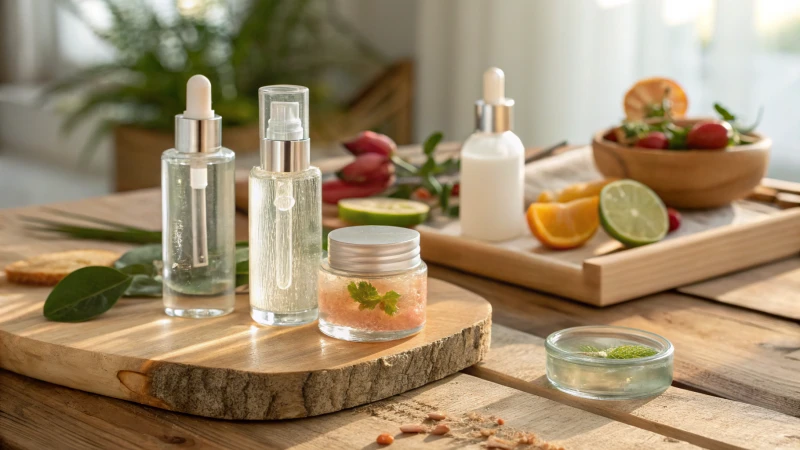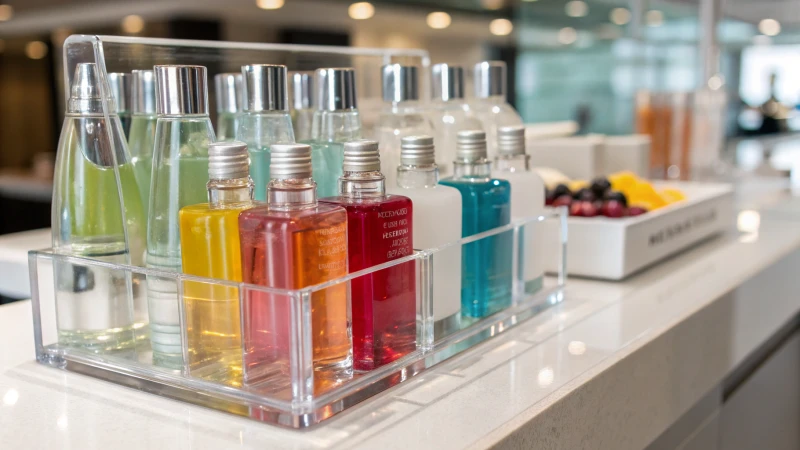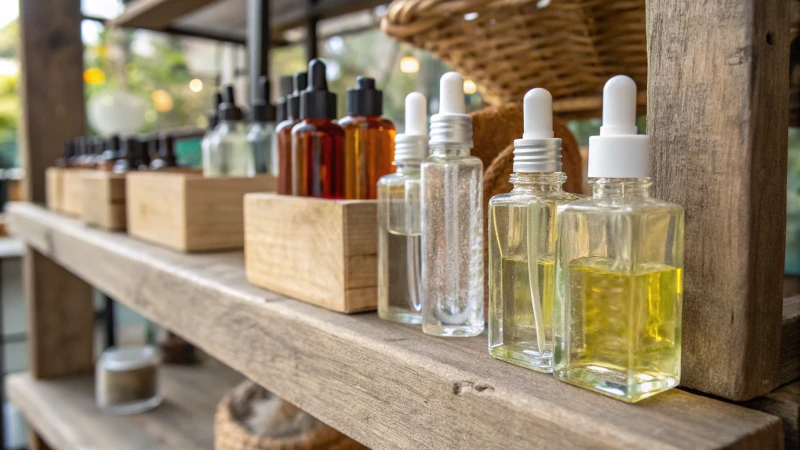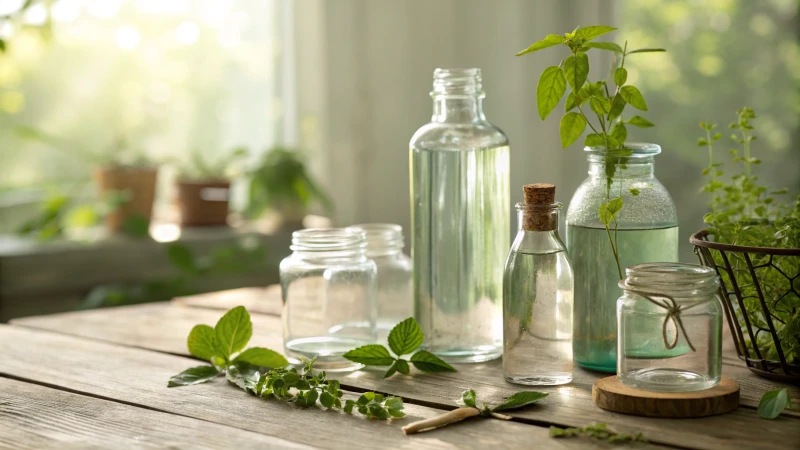
Remember the last time you were drawn to a product just by its packaging? There’s a reason transparent glass can be so captivating!
Transparent glass packaging fosters a sense of trust and authenticity with consumers, making them feel assured about the quality of the product inside. This psychological effect stems from years of associating transparency with honesty and genuine ingredients, significantly impacting buying decisions.
I remember walking through a store, picking up a beautifully packaged skincare product just because the glass was so clear. It felt like I was getting a peek into something precious and honest. That moment of seeing exactly what you’re getting builds an unspoken trust. But beyond this, brands face challenges with glass, like balancing production costs and ensuring product stability against environmental factors. Interestingly, as eco-consciousness rises, using sustainable glass becomes a double-edged sword—promising authenticity while grappling with greenwashing debates. For anyone in business, understanding these nuances can be the difference between making a sale or losing a customer.
Transparent glass packaging increases consumer trust in cosmetics.Vrai
Transparency suggests honesty and authenticity, boosting consumer confidence.
Opaque packaging is preferred over transparent for premium cosmetics.Faux
Transparent packaging is often associated with quality, not less premium.
How does transparent glass influence our buying choices?
Remember that moment when you picked up a product just because you could see what was inside? There’s more to that choice than meets the eye!
Transparent glass forms a psychological contract with consumers by signaling transparency and authenticity. This subtle agreement builds trust, suggesting the product is genuine and of high quality, which often sways purchasing decisions.

How Does Transparent Glass Communicate Trust?
I remember my first experience with transparent packaging vividly. It was a sweltering summer day, and I was desperately searching for a refreshing drink. My eyes fell on a beautifully clear bottle, filled with a vibrant orange liquid. There was something about being able to see the product that made me trust it instantly—no hidden surprises, just pure refreshment. This is how transparent glass works its magic; by offering a glimpse into the product, it whispers promises of honesty and quality.
The transparency of glass packaging naturally signifies openness and honesty. Consumers often equate the ability to see a product with authenticity1, leading to greater trust in the brand. By allowing consumers a peek into what they are purchasing, brands promise nothing is hidden. This "see-through" effect suggests no deception is involved, thus fostering a sense of security in the consumer’s mind.
The Subconscious Influence on Purchasing Decisions
It’s fascinating how our minds work, isn’t it? Without even realizing it, we often lean towards transparent packaging, equating it with honesty. Just like my quick decision at the beverage aisle, many of us subconsciously choose clarity over opacity. It’s like our brains have been trained to associate transparency with trustworthiness, thanks to years of clever marketing.
The psychological contract formed by transparent glass isn’t always an overt decision by consumers. Many buyers may not explicitly realize that transparency affects their decisions. Yet, studies indicate that when given a choice between opaque and clear packaging, many tend to choose the latter, driven by the perceived "honesty" factor.
The Role of Market Conditioning
Transparent packaging has long been a silent salesman. It’s been ingrained in us to associate glass2 with purity and premium quality, especially in beauty products. I’ve seen firsthand how brands capitalize on this association, crafting an image of elegance and integrity that lures customers in without uttering a single word.
Decades of marketing have conditioned consumers to associate transparent packaging with purity and high quality. This conditioning is especially prevalent in industries like cosmetics where ingredient purity is paramount. Brands leverage this subconscious belief to elevate their market presence and perceived value.
| Transparent Glass Benefits | Impact on Consumer Perception |
|---|---|
| Visibility of product | Trust and transparency |
| Perceived product purity | Higher quality perception |
| Elegant aesthetic | Premium brand image |
Sustainability’s Role in the Psychological Contract
In today’s world where sustainability matters more than ever, using eco-friendly glass can elevate a brand’s image significantly. When I learned about brands opting for sustainable materials, it made me view them as not just transparent but responsible too. This adds another layer to the psychological contract between brands and consumers—one that speaks of ethics and care for our planet.
With increasing environmental awareness, the use of eco-friendly glass materials enhances a brand’s image further. Consumers are likely to perceive brands using sustainable glass as more responsible and ethical, adding another layer to the psychological contract.
The Impact on Brand Positioning
Choosing the right type of glass is like picking the perfect outfit for an important event—it says a lot about who you are. High-end brands often go for lead-free or specially coated glass to maintain their premium status. It’s a choice that tells consumers they’re getting something special crafted with quality and safety in mind.
Choosing the right type of glass can significantly influence brand positioning. High-end brands may opt for lead-free or specially coated glass to maintain a premium image—a choice that not only affects production cost3 but also communicates the brand’s commitment to quality and safety.
Transparent glass signifies openness and honesty to consumers.Vrai
Consumers associate transparency with authenticity, fostering trust.
Opaque packaging is preferred over transparent for perceived quality.Faux
Studies show consumers often choose clear packaging for its honesty factor.
How Do Material Choices in Glass Affect Brand Positioning and Costs?
Ever thought about how the glass you choose for your products might shape your brand’s image and wallet?
Selecting the right glass material for packaging can greatly influence your brand’s positioning and cost structure. High-quality glass projects luxury and eco-consciousness but comes with higher costs, while standard glass is budget-friendly but may compromise premium appeal.

Consumer Perception and Brand Image
I remember when I first dove into the world of glass packaging; it was like stepping into a different realm where transparency wasn’t just about seeing through but about showcasing purity and authenticity. Transparent glass, with its clarity, seems to whisper promises of honesty and genuine ingredients to consumers. That’s why many luxury brands lean towards lead-free or colored glass, enhancing their premium and eco-friendly4 image. This choice isn’t just a superficial one—it’s a cornerstone of how consumers perceive the brand.
Cost Implications
Navigating the maze of production costs tied to glass choices was quite the learning curve for me. Lead-free glass, with its pristine transparency, does wonders for brand image, yet it also brings along higher manufacturing costs. Here’s a little comparison:
| Glass Type | Cost Implication | Brand Impact |
|---|---|---|
| Standard Glass | Lower cost | Mass-market appeal |
| Lead-Free Glass | Higher cost | Premium image |
| Colored Glass | Moderate cost | Niche appeal |
While standard glass might be easy on the budget, it risks diluting a high-end brand’s appeal. It’s all about striking that delicate balance.
Environmental Considerations
I’ve often pondered the eco-friendliness of glass. While it’s lauded as sustainable5, its energy-intensive production process is a real concern. For brands eager to flaunt their green credentials, choosing manufacturers who leverage renewable energy is crucial to mitigating environmental impact.
Supply Chain and Logistics
The fragility of glass in transit can be a nightmare—trust me, I’ve been there. Damage rates during shipping can not only hike costs but also tarnish brand reputation. Investing in tempered glass or robust packaging solutions can significantly enhance supply chain efficiency6.
Product Integrity and Protection
If you’re working with light-sensitive ingredients like essential oils, the type of glass you choose could make or break product stability. Using UV-protective coatings or opting for colored glass ensures your products remain effective and keep your customers coming back for more.
Transparent glass symbolizes purity and authenticity.Vrai
Transparent glass is perceived as pure and authentic, enhancing brand image.
Lead-free glass is cheaper than standard glass.Faux
Lead-free glass costs more due to higher quality and premium positioning.
Can Transparent Glass Compromise Product Integrity and Stability?
Ever wondered if the clarity of transparent glass could be a double-edged sword for your products?
Transparent glass can compromise product integrity by allowing light exposure, which may degrade sensitive ingredients. Protective coatings or tinted glass can help preserve stability, especially for light-sensitive products like cosmetics.

The Role of Light Exposure in Product Stability
I remember the first time I encountered the issue of light exposure with transparent glass. It was during a product launch for a new line of essential oils, where the elegant, clear bottles looked stunning under the display lights. However, a few weeks in, customers started complaining about changes in the scent and efficacy of the oils. It hit me then—transparent glass, while beautiful, can expose products to harmful light, compromising sensitive ingredients like those in essential oils and natural plant extracts7. This experience taught me the importance of considering alternatives like colored glass or UV-protective coatings.
Solutions to Light Sensitivity
To tackle light exposure issues, some brands—including mine—have turned to tinted glass solutions:
| Glass Type | Benefits |
|---|---|
| Amber Glass | Blocks UV light effectively |
| Purple Glass | Offers aesthetic appeal and UV protection |
| Coated Glass | Provides a clear view with protective layering |
Material Choice and Its Impact on Brand Perception
The type of glass you choose doesn’t just affect the product; it speaks volumes about your brand. I’ve learned that opting for lead-free glass not only enhances transparency but also sends a message of "premium" and "health-conscious" branding. This choice is especially crucial in markets like Europe, where quality perception can make or break a brand.
Sustainability Challenges with Transparent Glass
Despite its reputation for being eco-friendly, I’ve discovered that glass production is surprisingly energy-intensive. The journey towards aligning our manufacturing processes with true sustainability is ongoing. Partnering with companies that use renewable energy sources8 has been an effective way to boost our eco-credentials, ensuring we walk the talk when it comes to environmental claims.
Logistics Considerations: Handling Fragility
Handling the delicate nature of transparent glass has been one of our most significant logistical challenges. With damage rates ranging from 5% to 8%, it’s essential to strike a balance between aesthetics and durability. We’ve experimented with tempered glass and optimized packaging designs to minimize breakage risks, ensuring our products arrive intact and ready to impress.
| Logistics Factor | Solution |
|---|---|
| High Damage Rate | Use tempered or specially treated glass |
| Shipping Costs | Optimize packaging design |
By considering these factors, I’ve learned how to maintain product integrity while leveraging the undeniable allure of transparent glass.
Transparent glass allows harmful UV light exposure.Vrai
Transparent glass doesn't block UV light, risking photodegradation.
Amber glass is ineffective against UV light.Faux
Amber glass effectively blocks UV light, protecting contents.
Is Transparent Glass Truly an Eco-Friendly Packaging Option?
Transparent glass has this magical ability to make things feel purer and more authentic, right? But is it really the green choice we think it is? Let’s dig into whether glass packaging lives up to its eco-friendly hype.
While transparent glass can be recycled endlessly and is crafted from natural materials, its production is energy-intensive, leading to a significant carbon footprint. This makes its environmental friendliness questionable compared to alternatives like recycled plastics or paper.

The Production Footprint of Transparent Glass
I’ve always been drawn to the elegant look of transparent glass packaging. It promises clarity and honesty—qualities I hold dear. But beneath that charm lies a production process9 that’s anything but simple. Creating glass requires intense heat, leading to substantial carbon emissions. I remember my first visit to a glass manufacturing plant; the sheer energy consumption blew my mind! The Glass Packaging Institute10 notes that over 30% of glass production costs are tied to energy use alone. It’s like paying a premium for beauty that comes with a hidden environmental tax.
Recycling and Sustainability Factors
One of the things I love about glass is its infinite recyclability. There’s something satisfying about using a product that can be endlessly reused without degrading in quality. However, the recycling process isn’t free from its own energy demands. How green it really is depends on factors like how often glass is recycled and how far it travels from production to your home. It’s like trying to balance on a seesaw, where every decision affects the environmental impact.
| Matériau | Recyclability | Energy Use |
|---|---|---|
| Verre | Infinite | High |
| Plastic | Limited | Moderate |
| Paper | Limited | Low |
Comparing Glass to Other Materials
When I weigh glass against other materials like plastic or aluminum, I can’t help but wonder about the entire lifecycle of each product. Glass is heavier, which means higher emissions during transportation. It reminds me of those times when packing my suitcase—I want to bring everything, but the weight adds up quickly! Plastics offer lighter alternatives, cutting down on transport emissions significantly.
Addressing "Greenwashing" Concerns
Many brands use transparent glass as a symbol of sustainability, but sometimes it feels like window dressing—literally and figuratively. This tactic, known as greenwashing11, can mislead consumers about a product’s true environmental impact. It’s like finding out your favorite “organic” snack isn’t all that wholesome after all.
The real challenge for brands is harmonizing the premium appeal of glass with genuine sustainable practices. When choosing between glass and other packaging materials, we should consider not just looks but the overall environmental footprint and lifecycle costs.
Glass production is energy-intensive and emits significant carbon.Vrai
Glass requires high temperatures to manufacture, leading to high energy use.
Glass recycling does not consume any energy.Faux
Recycling glass uses energy, though less than producing new glass.
Conclusion
Transparent glass packaging enhances consumer trust and perceived product quality, influencing purchasing decisions while posing challenges in production costs, sustainability, and ingredient protection.
-
Understand how transparency in packaging builds consumer trust and affects buying decisions. ↩
-
Explore reasons behind consumer preferences for transparent packaging over opaque alternatives. ↩
-
Learn how different types of glass affect brand image and market positioning. ↩
-
Discover how lead-free glass enhances premium branding by improving transparency and perceived value. ↩
-
Understand the environmental implications of glass production and explore sustainable practices. ↩
-
Learn about strategies to minimize shipping damage using tempered or reinforced glass. ↩
-
Explore how photodegradation affects natural plant extracts, impacting their efficacy and shelf life. ↩
-
Learn about how using renewable energy in glass production can enhance sustainability efforts. ↩
-
Learn about the energy demands in glass manufacturing to assess its environmental impact. ↩
-
Explore detailed data on glass production costs and energy consumption for a deeper understanding. ↩
-
Discover how some companies might mislead consumers by overstating their eco-friendly credentials. ↩



